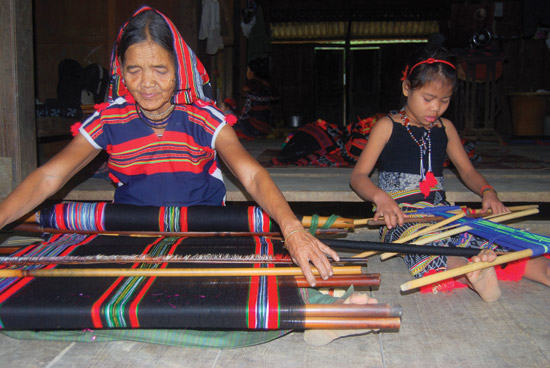(No.7, Vol.2, July 2012 Vietnam Heritage Magazine)
Công D?n Village of the C? Tu tribe in Zuôih Commune of Nam Giang District in the Southern Central Vietnam province of Quang Nam is in a narrow valley on the Vietnam-Laos border.
The stilt houses with the roofs in the shape of a mango.
Doctor of ethnology Tran Tan Vinh, Director of Quang Nam’s Museum said ‘Công D?n Village is the only place in the area of Truong Son range and Central Highlands where the traditional craft of weaving with all production processes from growing cotton to spinning, dyeing and weaving still survive.’
‘Our Công D?n villagers wouldn’t be Công D?n villagers any more if we didn’t weave cloth. Here, a girl of nine or ten years old knows how to make cloth and a boy that age goes with his father to plant cotton trees on the farm and collect dyes,’ Aviet Crai, 40, a C? Tu said, pointing to two looms in his house. Crai said the villagers usually wove at night, when they did not have to go to their farms.

Bling Hanh, 61, who is famous for making clothes from barks and knows a lot about weaving in Công D?n Village, said the cotton trees grown in Công D?n had been there a long time and had come from Laos.
Bling Hanh said, ‘During wartime, our village also grew cotton trees to make cloth for our needs. The seeds from our ancestors have been with us for generations until now.’
The C? Tu people in Công D?n Village use leaves of some special trees in the forest to make dyes for the thread. Recently, they have begun to grow these trees near their houses to save time.
To dye the thread black, they grind burned corn and mix the powder with water made from a kind of root. Then, they soak the thread in the water. For other colours, they soak the cloth in water blended with quicklime.
‘There are 98 households in our village. All the houses weave except Mrs Alang En, who is almost 100 years old and can’t do the work any more. Just a few houses have only one loom. The other houses all have two or three looms. There are big looms for adults small looms for children,’ said 40-year-old woman Jorum Bang who is chief of Công D?n Village’s Women Union.
Jorum Bang said that the young women in the village use industrially made cloth but they still like to learn the traditional craft. Some 18-year-old girls are already very skilful in making thread.
‘The cloth we make is thick, strong and soft. It keeps us warm in the rainy season and cool in the sunny season. We C? Tu people are only beautiful and really C? Tu when we wear the clothes we make ourselves,’ 75-year-old woman Bling Pa said.
Bling Pa said it took a lot of time and effort to make a piece of cloth and the most difficult part was turning cotton into thread. Young people had to work hard and learn little by little for a long time before being able to turn cotton into thread. This part of the work was usually done by older women.
Preparing the cotton, turning cotton into thread, dyeing and weaving require diligence, so it is done by women. Men take care of building the looms, tools used to prepare the cotton, frames to turn cotton into thread, growing and taking care of the cotton trees, finding the trees and other materials to make the dyes.
To avoid getting bored, women usually take their looms to the village’s communal house or go to their neighbours so that they can chat while working. An excellent weaver can make only five or six skirts a year.

